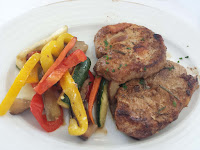 Recently I had the opportunity to join fellow wine bloggers and representatives from CVNE (Compañía Vinícola del Norte del España) for a fantastic wine dinner at DC's Barcelona Restaurant. The parent company operates bodegas in two of Rioja's three subregions: Rioja Alta and Rioja Alavesa - aka Basque wine country. CVNE is actually pronounced Coo-nay because way back in 1879 for their inaugural vintage, the labels were misprinted as CUNE. But Brothers Eusebio and Raimundo Real de Asúa decided to keep the name for an easier pronunciation.
Recently I had the opportunity to join fellow wine bloggers and representatives from CVNE (Compañía Vinícola del Norte del España) for a fantastic wine dinner at DC's Barcelona Restaurant. The parent company operates bodegas in two of Rioja's three subregions: Rioja Alta and Rioja Alavesa - aka Basque wine country. CVNE is actually pronounced Coo-nay because way back in 1879 for their inaugural vintage, the labels were misprinted as CUNE. But Brothers Eusebio and Raimundo Real de Asúa decided to keep the name for an easier pronunciation.During the dinner, International Director Joan Pujol and USA Area Manager Gloria Zapatero relayed other stories about this historic winery including Spain's oldest white wine Monopole. First produced in 1915, the wine was first made using the Viura grape plus other non-Rioja Spanish fruit. The wine became 100% Viura in the 1980s when the Rioja DOC was institutionalized and is now known - at least for me - for its savory, stoney, and creamy orange blossom character. In another luck of fate, and elderly American customer visited the winery not long ago, sampled the Monopole, and remarked that it wasn't what he had remembered. The owner stepped into his private cellar pulled out a 1979 vintage and both the owner and customer where pleased with the aged wine. And thus the concept for the Cune Monopole Clasico was born. The winery un-retired the former winemaker who was the only person with knowledge of the blend and process. And in a few weeks this wine will be available in the United States.
 |
| Courtesy of CVNE |
The Imperial brand began in the 1920's in Rioja Alta the westernmost part of Rioja's three subregions. The vineyards in Villalba, Briones and Montalvo are influenced by the Atlantic Ocean and contain deposits of iron, salts, limestone and clay. The name Imperial comes from the special bottling for the English market known as an ‘Imperial Pint’ (half a liter). The wines for the Imperial label are aged in the CVNE Eiffel designed cellar. Mr. Pujol noted that wines from Rioja Alta are generally more acidic which favors longer aging potential.
The Viña Real brand was also launched in the 1920s, this time in Rioja Alavesa - located in Basque country. The vineyards extend from the Sierra de Cantabria towards the Ebro river basin which protect the area from harsher weather formed in the Atlantic. The soil combines with calcareous and clay-based soils. Mr. Pujol noted that there area produces riper wines and this winery is best known for their Crianza wines.
Contino became the first Rioja château in 1973 and is located in the Rioja Alavesa. "The history of the property dates from the 16th century, and is reflected in its name. The contino was the officer in charge of a guard corps of a hundred soldiers who protected the royal family de contino (continuously) from the times of the Catholic Monarchs onwards." The grapes used in the Contino brand are exclusively from the 62 hectares Laserna vineyards which are protected by the Cerro de la Mesa hills.
Here are the wines we enjoyed during the evening. Cheers.
Cune Monopole 2015 ($15) 100% Viura - the most widely planted white grape variety in Rioja. The oldest white wine brand of Spain, produced since 1915. This wine is one smooth operator: laid back, self-assured, stony and creamy orange blossoms, with just enough acids to make you notice.
Cune Monopole Clásico 2014 ($25) Viura & other grape varieties. Fermented in stainless steel then rests on lees in 300l and 500l oak barrels for eight months. Very complex with multiple flavors - all of the spectrum. Fresh finish from solid acidity.
Vina Real Crianza 2011 ($15) 90% Tempranillo, 10% Garnacha, Graciano and Mazuela. This is a light bodied wine, bright cherries, a dusty structure and finishes smooth and vibrant. An outstanding value for an everyday wine.
Vina Real Reserva 2010 ($45) 90% Tempranillo, 10% Graciano, Grenache and Mazuelo. Aged one year in oak and two years in bottle before release. Deep color and flavors, round and full, dried fruit, and very smooth.
Imperial Reserva 2009 ($45) 85% Tempranillo, 10% Graciano and 5% Mazuelo. The wine is macerated and primary fermented in oak with the malolatic fermentation proceeding in concrete. The wine is juicy smooth, with excellent structure, vanilla and spices, and a long semi-tannic finish.
Imperial Gran Reserva 2009 ($55) 85% Tempranillo, 10% Graciano and 5% Mazuelo.Aging in cask for three years and in bottle for two years before release. Only wine from the best barrels were reserved for the Gran Reserva which shows in the wine with it's excellent structure, hints of earth, and long smooth finish. Fantastic
Contino Reserva 2009 ($48) 85% Tempranillo, 10% Graciano, 5% Mazuelo & Garnacha. After being opened all day the wine tasted of figs and raisins, but remained fresh.













































